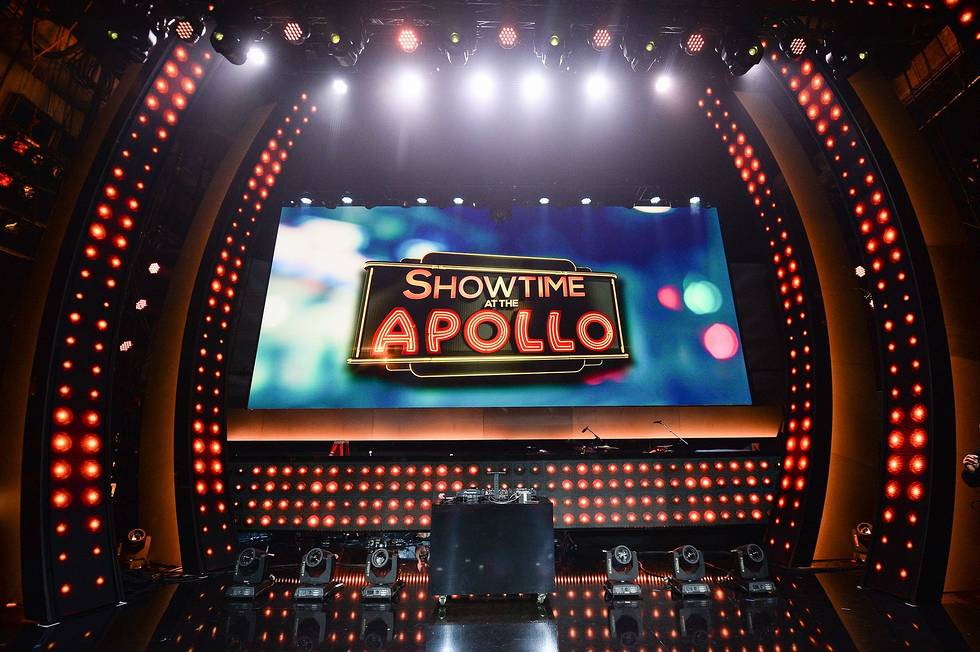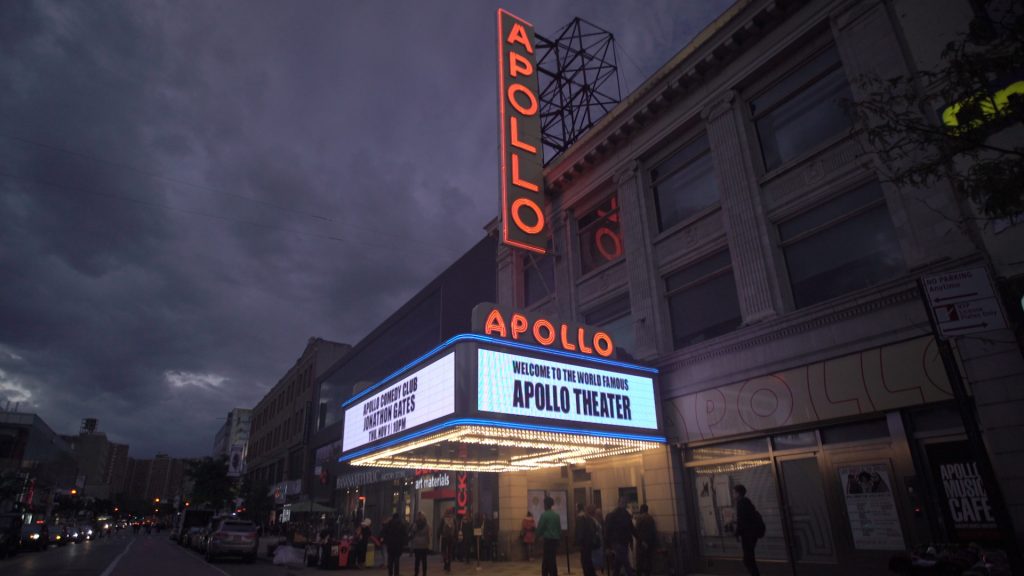Appollo Drawing Black and White
Since opening its doors in 1914 and introducing the first Amateur Night contests in 1934, the Apollo has played a major role in the emergence of jazz, swing, bebop, R&B, gospel, blues, and soul — all quintessentially American music genres. Ella Fitzgerald, Sarah Vaughan, Billie Holiday, Sammy Davis Jr., James Brown, Gladys Knight, Luther Vandross, D'Angelo, Lauryn Hill, and countless others began their road to stardom on the Apollo stage. Today, the Apollo is a respected not-for-profit, presenting concerts, theatrical and dance performances, film screenings, education and community outreach programs.
The neo-classical theater known today as the Apollo's HistoricTheater was designed by George Keister and first owned by Sidney Cohen. In 1914, Benjamin Hurtig and Harry Seamon obtained a thirty-year lease on the newly constructed theater calling it Hurtig and Seamon's New Burlesque Theater. Like many American theaters during this time, African-Americans were not allowed to attend as patrons or to perform.
In 1933 Fiorello La Guardia, who would later become New York City's Mayor, began a campaign against burlesque and Hurtig & Seamon's was one of many theaters that would close down. Cohen reopened the building as the 125th Street Apollo Theatre in 1934 with his partner, Morris Sussman serving as manager. Cohen and Sussman changed the format of the shows from burlesque to variety revues and redirected their marketing attention to the growing African-American community in Harlem.
Frank Schiffman and Leo Brecher took over the Apollo in 1935. The Schiffman and Brecher families would operate the Theater until the late 1970s.The Apollo reopened briefly in 1978 under new management then closed again in November 1979. In 1981, it was purchased by Percy Sutton, a prominent lawyer, politician, media and technology executive, and a group of private investors. Under Sutton's ownership, the Theater was equipped with a recording and television studio.
In 1983, the Apollo received state and city landmark status and in 1991, Apollo Theater Foundation, Inc., was established as a private, not-for-profit organization to manage, fund and oversee programming for the Apollo Theater. Today, the Apollo, which functions under the guidance of a Board of Directors, presents concerts, performing arts, education and community outreach programs. Soon, the Apollo will embark on expanding its physical footprint, becoming the operator and manager for the cultural space located a few doors down within the Victoria Theater Redevelopment Project. The Apollo's Victoria Theater's will provide vibrant, year-round artistic, educational, and community programs that build on the cultural heritage of Harlem and celebrate the enormous well of creativity found in our neighborhood.
THE THIRTIES
- On January 26, 1934, the 125th Street Apollo Theater opens with the show "Jazz a la Carte" headlined by Benny Carter and his Orchestra, Ralph Cooper and Aida Ward.
- The Apollo becomes the premiere showplace for live, theatrical entertainment in Harlem.
- Dewey "Pigmeat" Markham, Jackie "Moms" Mabley and Dusty Fletcher are among the comedians who appear regularly on stage.
- Tap Dancers like the Nicholas Brothers, Berry Brothers, Bill "Bojangles" Robinson, Buck and Bubbles are the top dance acts.
- Amateur Night winners include Ella Fitzgerald and Pearl Bailey
- By 1937 the Apollo is the largest employer of black theatrical workers in the US, according to Frank Schiffman, and the only theater in NYC hiring blacks in backstage positions.
- In 1935, Bessie Smith's four weeks at the Apollo are her sole live performances that year.
- Billie Holiday, Lena Horne & the Count Basie Orchestra make their debut.
- The Apollo Chorus Girls are considered to be the best line in NYC. In 2005, their story is recounted in the documentary "Been Rich All My Life."
THE FORTIES
- Lionel Hampton 16-piece band appears at the Apollo. Hampton's hit, "Flyin' Home," becomes an Apollo favorite.
- Teddy Hale, Babe Laurence and Bunny Briggs are the top dance attractions.
- During World War II the Apollo sets aside 35 tickets daily for soldiers. Tuesdays at the USO were "Apollo Night."
- Dinah Washington and Sammy Davis, Jr. make their first Apollo appearance.
- Amateur Night winners during the 1940s include Sarah Vaughn and Ruth Brown
- Apollo comics stop using blackface makeup.
THE FIFTIES
- The Johnny Otis Rhythm & Blues Caravan come to Apollo featuring 13-year old Little Esther Phillips.
- The week before Christmas 1951, Josephine Baker, makes her Apollo debut.
- "Mambo Shows" are a big Apollo attraction with stars like Tito Puente, Mongo Santamaria & the Mambo Aces.
- Comedy acts like "Harlem's Son of Fun," Nipsey Russell, Timmie Rogers & James "Stump" Cross and Harold "Stumpy" Cromer are a major draw.
- "The Detective Story," with Sidney Poitier is the first dramatic play to be shown on the stage.
- In 1955, Thurman Ruth's Gospel Caravan debuts at the Apollo featuring such as The Dixie Hummingbirds, Shirley Caesar, Alex Bradford, Clara Ward & the Soul Stirrers.
- Amateur Night contestants include the Esquires, Dionne Warwick, Joe Tex, and James Brown.
- In 1955, Disc jockey Tommy "Dr. Jive" Smalls brings the idea of the Rhythm and Blues Revue to Apollo manager Bobby Schiffman. The shows feature as many as a dozen vocal acts on 1 bill.
- "Showtime at the Apollo" is first broadcast in 1955, taped before a live studio audience. Performers include Sarah Vaughn, "Big" Joe Turner, Herb Jeffries, the Count Basie Orchestra, comedian Nipsey Russell, and the dancer Bill Bailey. Willie Bryant is the host.
- Jazz greats like Miles Davis, John Coltrane and Thelonius Monk appear at the Apollo.
THE SIXTIES
- Nancy Wilson makes her Apollo debut. The Miracles, with Smokey Robinson, appear on Ray Charles' show.
- A Scepter Records show package includes the Shirelles, Chuck Jackson, Tommy Hunt, Maxine Brown and the Isley Brothers.
- Amateur Night winners include Gladys Night, King Curtis, Ronnie Spector, Billy Stewart, Jimi Hendrix and Charlie and Inez Foxx.
- The Jewel Box Revue, "25 Men and 1 Girl", is one of the most popular shows and features performances by transvestites.
- Sam and Dave, Wilson Pickett, Otis Redding, Joe Tex, and especially Aretha Franklin, present the grittier side of soul at the Apollo
- James Brown records live shows at the Apollo in 1962.
- The "Motortown" Revue debuts with the Supremes, Marvin Gaye, the Temptations, the Four Tops, Gladys Knight and the Pips, the Commodores and "Little" Stevie Wonder.
- "Blues Nights" features B.B. King, Bobby "Blue" Bland, T-Bone Walker, Sonny Terry & Brownie McGhee, Jimmy Witherspoon, and Odetta.
THE SEVENTIES
- Aretha Franklin's Apollo shows are major events. The Apollo marquee reads, "She's Home."
- Stars of the Philadelphia International record label including the Delfonics, the O'Jay's, the Stylistics, the Spinners, the Three Degrees and Harold Melvin and the Blue Notes are presented.
- John Lennon and Yoko Ono appear at a 1971 benefit concert for Attica.
- B.B. King plays an early morning blues concert for Harlem schoolchildren.
- By the mid 1970s, the Apollo is presenting only 22 weeks of shows per year as recordings eclipse live performances as an important source of income for artists.
- Bobby Schiffman reluctantly closes the Apollo in January 1976.
- The Theater briefly reopens in 1978 under new management with shows by Ralph McDonald, War, the T-Connection and Sister Sledge, James Brown, Bob Marley and Parliament Funkadelic.

THE EIGHTIES
- In 1981, Percy Sutton's Inner City Broadcasting Corporation and a group of private investors purchase the Apollo Theater. The Apollo receives state and city landmark status as Harlem's oldest functioning theater in 1983.
- On May 5th, 1985 the Apollo's renovation is celebrated with a 50th Anniversary grand reopening and television special, "Motown Salutes the Apollo." Amateur Night is re-launched on Christmas Eve that same year.
- Showtime at the Apollo is revived and launched as a television show.
THE NINETIES TO PRESENT
- The Apollo Theater Foundation, Inc., a not-for-profit organization is established to manage, fund and program the Apollo Theater.
- The Artist formerly known as Prince plays the Apollo in an exclusive VH1 Concert.
- The Apollo Theater Foundation launches its first performance series with a tribute to Dr. Martin Luther King, Jr. Other performances follow including Alvin Ailey Dance Theater, Boys Choir of Harlem and Betty Carter – Jazz Ahead '95.
- Tony Bennett plays a sold-out engagement honoring Billie Holiday.
- In 2002, George C. Wolfe's new musical Harlem Song opens to enthusiastic.
- The Theater hosts its inaugural Spring Benefit Gala in 2005 with a special tribute Ossie Davis.
- The first phase of renovation is completed and includes the installation of over 1,500 house seats, restoration of the 125th-Street façade, a, state-of-the-art Marquee, new stage and greenroom.
- In 2006 Apollo legendJames Brown lays in state on the Apollo stage. Tens of thousands of people gather to pay their respects.
- Then-Senator and Democratic presidential candidateBarack Obama hosts a campaign fundraiser at the Apollo. (2007)
- Thousands ofMichael Jackson fans flock to the Apollo Theater to pay tribute to the pop icon, celebrate his life, and mourn his death. (2009)

Learn More About the Apollo
Want to learn more about the Apollo and its rich history? Book a tour!
Appollo Drawing Black and White
Source: https://www.apollotheater.org/about/history/
0 Response to "Appollo Drawing Black and White"
Post a Comment